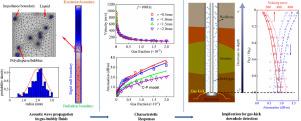International Journal of Mechanical Sciences ( IF 7.1 ) Pub Date : 2021-12-03 , DOI: 10.1016/j.ijmecsci.2021.106979 Zizhen Wang 1, 2 , Weidong Zhou 1, 2 , Tengfei Shu 2, 3 , Qilong Xue 4 , Rui Zhang 1, 2 , Marian Wiercigroch 5, 6

|
A numerical modelling method for the low-frequency (∼102 Hz) acoustic wave propagation in a bubbly fluid with a low gas fraction is developed in this paper. Based on the digital image analysis of the bubbly fluid, the geometrical model of polydisperse bubble populations is created. The developed method is first verified by the Wood's (1955) equation and the Commander & Prosperetti (1989) model. Then the influence of gas fraction, excitation frequency and bubble radius on the acoustic properties of the bubbly fluid is systematically examined. The obtained results confirmed that the velocities and attenuations for different bubble radius distributions are close to those obtained for the monodisperse models. The gas fraction is the key controlling factor of the acoustic velocity, while the influence of the bubble size at low frequencies can be neglected. The velocity dispersion with frequency is about 5% even in Wood's regime and the attenuation increases with a higher gas fraction and excitation frequency, while it decreases with a smaller bubble radius. By estimation of bubble expansion during the migration of gas kick, variation trends of acoustic velocity and attenuation along the wellbore are discussed. This implies that variations of the velocity and attenuation of drilling fluid at low-frequencies during the gas migration can be used for an accurate and earlier gas kick detection than currently used methods.
中文翻译:

稀气泡液体中低频声波传播的建模
低频 (∼10 2 Hz) 声波在具有低气体分数的气泡流体中的传播在本文中被开发。基于气泡流体的数字图像分析,创建了多分散气泡种群的几何模型。开发的方法首先通过 Wood's (1955) 方程和 Commander & Prosperetti (1989) 模型进行验证。然后系统地研究了气体分数、激发频率和气泡半径对气泡流体声学特性的影响。获得的结果证实,不同气泡半径分布的速度和衰减与单分散模型获得的速度和衰减接近。气体分数是声速的关键控制因素,而低频气泡尺寸的影响可以忽略不计。即使在伍德状态下,速度与频率的离散度也约为 5%,衰减随着气体分数和激发频率的增加而增加,而随着气泡半径的减小而减小。通过对气涌运移过程中气泡膨胀的估计,讨论了声速和沿井筒衰减的变化趋势。这意味着在气体运移过程中低频钻井液的速度和衰减的变化可以用于比目前使用的方法更准确和更早的气涌检测。讨论了声速和沿井筒衰减的变化趋势。这意味着在气体运移过程中低频钻井液的速度和衰减的变化可以用于比目前使用的方法更准确和更早的气涌检测。讨论了声速和沿井筒衰减的变化趋势。这意味着在气体运移过程中低频钻井液的速度和衰减的变化可以用于比目前使用的方法更准确和更早的气涌检测。











































 京公网安备 11010802027423号
京公网安备 11010802027423号